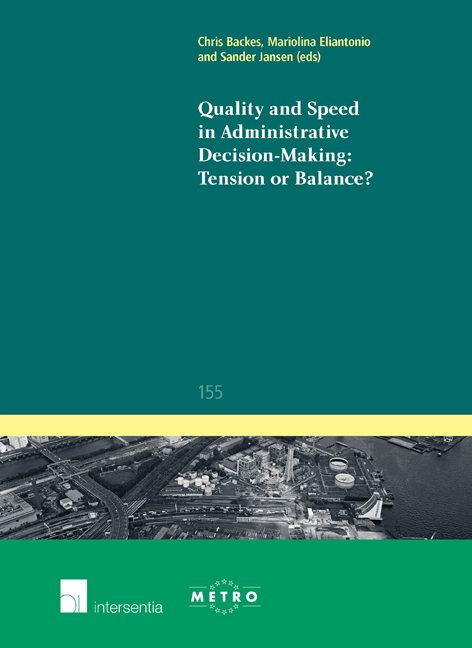Book contents
- Frontmatter
- Contents
- List of Authors
- List of Abbreviations
- Introduction
- Quality and Speed in Administrative Decision-Making: A German Case Study
- The Quest for Quality and Speed in Italian Administrative Law Or the Tale of some Elusive Targets
- Quality and Speed in Administrative Decision-Making: A French Case Study
- Planning for Major Infrastructure in England: Front-Loading Participation in the Interests of Efficiency
- Quality and speed in Judicial Procedures and Administrative Decision-Making: Environmental Permits in Sweden
- Faster and Better!? Decision-Making in the Netherlands
- Conclusions
- Ius Commune Europaeum
The Quest for Quality and Speed in Italian Administrative Law Or the Tale of some Elusive Targets
Published online by Cambridge University Press: 12 December 2017
- Frontmatter
- Contents
- List of Authors
- List of Abbreviations
- Introduction
- Quality and Speed in Administrative Decision-Making: A German Case Study
- The Quest for Quality and Speed in Italian Administrative Law Or the Tale of some Elusive Targets
- Quality and Speed in Administrative Decision-Making: A French Case Study
- Planning for Major Infrastructure in England: Front-Loading Participation in the Interests of Efficiency
- Quality and speed in Judicial Procedures and Administrative Decision-Making: Environmental Permits in Sweden
- Faster and Better!? Decision-Making in the Netherlands
- Conclusions
- Ius Commune Europaeum
Summary
Introduction
In 1979, Massimo Severo Giannini, a leading scholar in administrative law then serving as a Minister, drafted a report lamenting the overall inefficiency of the Italian bureaucracy. He was pressed into resignation and no changes took place. Italy was then at the height of its quasi-planned economy, with a swollen public sector made bigger by wave after wave of nationalizations and by a tendency to rescue and make into a public undertaking any failing or near bankrupt enterprise of less than minimal size. Efficiency had never been a serious concern. Ballooning public deficit coupled with ‘competitive’ devaluation of the Lira (a currency whose fall was not really mourned) were the default answers to the inevitable problems that ensued. The ‘clean hands’ probe exposed the fact that the Italian system was not just inefficient, but deeply corrupt (which should not have come as a surprise). With the benefit of hindsight one can say that while following the French pattern of the administrative nation state, Italy had failed to permanently incorporate into its institutional fabric those French characteristics which could warrant an acceptable degree of efficiency (and integrity). As has been noted, the meritocratic system for recruiting officials was weak to say the least; the Italian Council of State (Consiglio di Stato) ‘never attained the prestige and authority of its French counter part’, and the prefects soon became ‘a political instrument of the government’.
Growing competitive pressure after the Single European Act was to change the situation. The European Commission became serious about state aid – an indispensable lifeline for the inefficiently run public conglomerates which then made up the majority of the Italian economy. At a more generally encompassing level, the belated completion of the single – and later internal – market inevitably exposed a non-competitive economic system to ever growing challenges, making changes a life or death necessity. Moreover, the desire to enter the (then) future monetary union, which meant meeting the ‘Maastricht criteria’, brought about the need to finally curb the public debt. Speed and quality – or, to put it in one word, efficiency – in administrative decision-making procedures were values Italy could no longer ignore.
- Type
- Chapter
- Information
- Publisher: IntersentiaPrint publication year: 2016

